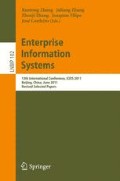Abstract
The increasing complexity and costs of modern production processes makes it necessary to plan processes virtually before they are tested and realized in real environments. Therefore, several tools facilitating the simulation of different production techniques and design domains have been developed. On the one hand there are specialized tools simulating specific production techniques with exactness close to the real object of the simulation. On the other hand there are simulations which simulate whole production processes, but in general do not achieve prediction accuracy comparable to such specialized tools. Hence, the interconnection of tools is the only way, because otherwise the achievable prediction accuracy would be insufficient. In this chapter, a framework is presented that helps to interconnect heterogeneous simulation tools, considering their incompatible file formats, different semantics of data and missing data consistency.
Access this chapter
Tax calculation will be finalised at checkout
Purchases are for personal use only
Preview
Unable to display preview. Download preview PDF.
References
Bernstein, P.A., Haas, L.M.: Information integration in the enterprise. Communications of the ACM - Enterprise Information Integration and Other Tools for Merging Data 51(9), 72–79 (2008)
Cerfontaine, P., Beer, T., Kuhlen, T., Bischof, C.H.: Towards a Flexible and Distributed Simulation Platform. In: Gervasi, O., Murgante, B., Laganà, A., Taniar, D., Mun, Y., Gavrilova, M.L. (eds.) ICCSA 2008, Part I. LNCS, vol. 5072, pp. 867–882. Springer, Heidelberg (2008)
Chappell, D.: Enterprise Service Bus. Theory in Practice. O’Reilly, Beijing (2004)
Conrad, S.: Enterprise Application Integration: Grundlagen, Konzepte, Entwurfsmuster, Praxisbeispiele. Elsevier, Spektrum, Akad. Verl., Heidelberg (2005)
Fox, M., Long, D.: PDDL2.1: An Extension to PDDL for Expressing Temporal Planning Domains. Journal of Artificial Intelligence Research 20(1), 61–124 (2003)
Ghallab, M., Nau, D.S., Traverso, P.: Automated planning. Theory and Practice. Elsevier/Morgan Kaufmann, Amsterdam (2004)
Goh, C.H.: Representing and reasoning about semantic conflicts in heterogeneous information systems. PhD thesis, Massachusetts Institute of Technology (1997)
Gronau, N.: Enterprise Resource Planning: Architektur, Funktionen und Management von ERP-Systemen, Oldenbourg, München (2010)
Halevy, A., Rajaraman, A., Ordille, J.: Data integration: the teenage years. In: Proceedings of the 32nd International Conference on Very Large Data Bases (VLDB), pp. 9–16. VLDB Endowment (2006)
Hoffmann, J., Nebel, B.: The planning system: Fast plan generation through heuristic search. Journal of Artificial Intelligence Research 14(1), 253–302 (2001)
Horridge, M., Patel-Schneider, P.F.: OWL 2 Web Ontology Language Manchester Syntax, W3C Working Group Note, W3C, October 27 (2009), http://www.w3.org/TR/owl2-manchester-syntax/
Horridge, M., Bechhofer, S.: The OWL API: A Java API for Working with OWL 2 Ontologies. In: Proceedings of the 5th International Workshop on OWL: Experiences and Directions (OWLED). CEUR Workshop Proceedings, vol. 529 (2009)
Kashyap, V., Bussler, C., Moran, M.: The Semantic Web, Semantics for Data and Services on the Web. Springer, Heidelberg (2008)
Kim, W., Seo, J.: Classifying schematic and data heterogeneity in multidatabase systems. Computer 24(12), 12–18 (1991)
Lavigne, C.: Advanced ETL with Pentaho Data Integration. Whitepaper, Breadboard BI (2006)
Leser, U.: Informationsintegration: Architekturen und Methoden zur Integration verteilter und heterogener Datenquellen. Dpunkt-Verl., Heidelberg (2007)
Meisen, T., Schilberg, D., Henning, K.: Planner Based Data Integration for Simulation Chains in Virtual Production. In: Proceedings of the International Conference on Science, Technology and Innovation for Sustainable Well-Being (STISWB), pp. 100–108. Klung NaNa Vithya Press Limited Partnership (2009)
Myerson, J.M.: The Complete Book of Middleware. Auerbach Publications, Boston (2002)
Panian, Z.: Supply chain intelligence in ebusiness environment. In: Proceedings of the 9th WSEAS International Conference on Computers (ICCOMP), pp. 1–6. World Scientic and Engineering Academy and Society (2005)
Rademakers, T., Dirksen, J.: Open-Source ESBs in Action. Manning Publications Co., Greenwich (2008)
Schilberg, D., Gramatke, A., Henning, K.: Semantic Interconnection of Distributed Numerical Simulations via SOA. In: Proceedings of the World Congress on Engineering and Computer Science (WCECS), pp. 894–897 (2008)
Schilberg, D.: Architektur eines Datenintegrators zur durchgängigen Kopplung von verteilten numerischen Simulationen. PhD thesis, RWTH Aachen University (2010)
Schmitz, G., Prahl, U.: Toward a virtual platform for materials processing. JOM Journal of the Minerals, Metals and Materials Society 61, 19–23 (2009)
Schroeder, W., Martin, K., Lorensen, B.: The Visualization Toolkit, Kitware Inc. (2004)
Schulte, R.W.: Predicts 2003: Enterprise service buses emerge. Technical report, Gartner (2003)
Sirin, E.: Pellet: A practical owl-dl reasoner. Web Semantics: Science, Services and Agents on the World Wide Web 5(2), 51–53 (2007)
Vassiliadis, P., Simitsis, A., Skiadopoulos, S.: Conceptual modeling for ETL processes. In: Proceedings of the 5th ACM International Workshop on Data Warehousing and OLAP (DOLAP), pp. 14–21. ACM, New York (2002)
White, C.: Data Integration: Using ETL, EAI and EII Tools to Create an Integrated Enterprise. Technical report, The Data Warehousing Institute (2005)
Author information
Authors and Affiliations
Editor information
Editors and Affiliations
Rights and permissions
Copyright information
© 2012 Springer-Verlag Berlin Heidelberg
About this paper
Cite this paper
Meisen, T., Meisen, P., Schilberg, D., Jeschke, S. (2012). Adaptive Information Integration: Bridging the Semantic Gap between Numerical Simulations. In: Zhang, R., Zhang, J., Zhang, Z., Filipe, J., Cordeiro, J. (eds) Enterprise Information Systems. ICEIS 2011. Lecture Notes in Business Information Processing, vol 102. Springer, Berlin, Heidelberg. https://doi.org/10.1007/978-3-642-29958-2_4
Download citation
DOI: https://doi.org/10.1007/978-3-642-29958-2_4
Publisher Name: Springer, Berlin, Heidelberg
Print ISBN: 978-3-642-29957-5
Online ISBN: 978-3-642-29958-2
eBook Packages: Computer ScienceComputer Science (R0)

